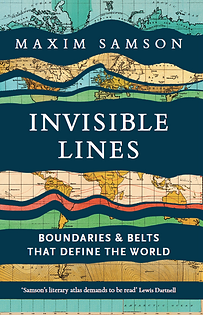Critical Acclaim for Earth Shapers

'A captivating and compelling account of how civilizations have made use of natural landscapes for their long-term benefit. From the astounding Incan road system to the building of Chicago and the Panama Canal, humans have a long history of shaping the Earth to build connections between ourselves. Samson demonstrates how we are not always prisoners of geography, but increasingly its masters'. Professor Lewis Dartnell.
'From railroads colonisers dreamed of building turning in projects designed by Africans, through to what travel routes will be used again when there is no longer a border within Korea, Earth Shapers tells stories that have been ignored because they do not fit the old narrative; a book that reshapes our story of global human geography'. Professor Danny Dorling.
'Samson takes a fresh lok at humanity's imprint on the planet ... A riposte to the idea that geography is destiny by charting the ways humans have reshaped their surroundings'. Pilita Clark, Financial Times.
'Accessible and erudite, Earth Shapers makes for a refreshing perspective on the relationship between human and physical geography. Ranging confidently from Chicago to Mozambique to Korea just as it travels across the history of technology, cities, nationalism, colonialism and liberation ... it is an original look at the geography of connection in an age where so much attention is given to the geography of division, to walls and borders'. Lewis Baston.
'This bold and rich collection ranges widely across five continents and an array of fascinating case studies, casting light on various meanings of geographical connectivity. Reading this book it's impossible not to learn something new'. Dr Sara Caputo.
'Modern geography is the geography of our personal, political and sociological souls. We urgently need to know what we are. Samson holds up a mirror, showing us ourselves reflected in what we've done. Fascinating, original and prescient'. Charles Foster.
'Well researched and wide-ranging, this book joins the dots, showing the power of connections between places'. Cliff Hague OBE.
'Humans are inveterate environmental meddlers. No guide to their excesses is more eloquent, more learned, more surprising, more amusing or more convincing than Maxim Samson. His lively language and minatory message are as entertaining as they are unsettling'. Felipe Fernández-Armesto.
Critical Acclaim for Invisible Lines

‘An illuminating glimpse of the chain reactions of human and physical geography’. Financial Times
‘Invisible Lines is a fascinating, detailed exploration of the hidden boundaries that carve up the world … it is a pleasure to accompany Samson to the Malaria Belt, inside eruvim (markers of a single domestic space within which fewer Sabbath regulations apply), or along the border of Portugal to discover why vultures prefer not to cross it’. The Telegraph.
‘A chance to see the world anew through the eyes of a wonderfully curious new writer’. The Observer.
‘Endlessly interesting’. Simon Winchester, The Spectator.
‘A fascinating book … a truly original adventure into new ways of exploring what we mean by a sense of place’. Simon Jenkins.
‘Old worlds enhanced, new worlds exposed and challenged … a wise and thought-provoking series of raids across borders we thought we knew and others made visible to us, by Maxim Samson’s forensic eye, for the first time’. Iain Sinclair.
‘Utterly engrossing! Samson’s literary atlas of the world’s unseen boundaries and how they’ve shaped our lives demands to be read’. Professor Lewis Dartnell.
‘The world is a mesh of lines. We don’t normally see them, and so we blunder on, unaware of where we really are and missing out on so much. Samson’s iconoclastic new geography will make the scales fall from your eyes. A tremendous and important read’. Charles Foster.
‘A journey to the unmarked and unseen borders that shape our world … a fascinating, extraordinary and insightful exploration of the many boundaries that define us’. Alastair Bonnett.
‘This absorbing book is an accessible and wide-ranging read, built upon erudition, curiosity and careful compilation. It reveals and reflects upon many types of divisions between places – stretching from the Antarctic to the Urals, and from the turfs of passionate soccer fans in Buenos Aires to linguistic divisions in Brittany, to name but a few’. Cliff Hague OBE.
‘[An] intricately detailed explanation of how each invisible line came to be, as well as what it can tell us about the world and our place within it … a fascinating read’. Geographical Magazine, Book of the Month.
‘A fascinating exploration of the lesser-known and more subtle borders across the earth and the surprising ways in which they shape our lives’. i news.
‘Samson’s clear and concise writing, his engaging style and the wide range of topics he covers makes Invisible Lines an absorbing study of the boundaries we set to divide and demarcate the physical and cultural worlds and how this affects us in our day-to-day lives’. Winnipeg Free Press.